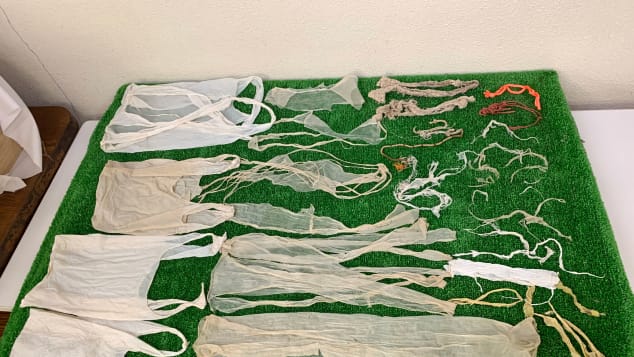Nara의 신성시 여기는 사슴을 구하기위해 야생동물이 먹을수있는 플라스틱백 발명한 일본인은 사슴이 먹지 말았어야할 플라스틱백을 먹고 소화가 안돼 죽어가는 모습을 보고, 사슴을 포함한 야생 동물이 씹었을때, 소화될수있는 재료를 사용하여 플라스틱백을 발명 했다는, 동물사랑 특종 뉴스가 CNN에 보도됐다. 사슴을 신성시 (sacred deer.)하는 종교적 사상이 그도시에는 있기 때문인것 같다.
Hidetoshi Matsukawa씨는 선물용품을 도매상에서 근무하는 Nara-ism에서 근무하고 있는 직원인데, 도시안에 공원에 나타난 사슴들이 소화를 시킬수 없는 플라스틱백을 먹고 죽어가는 소식을 듣고 "나는 Nara시의 상징인, 죽어가는 사슴을 보호하기위해 뭔가를 해야겠다는 생각이 들었었다"라고 만들게된 동기를 설명한다. 이도시에는 자연속의 보물이자, 신성시되고 있는 사슴 약 1,000여마리가 살고있는데, 많은 관광객들이 이들에게 먹을것을 사랑의 표시로 던져주곤 한다.
2019년 7월에 그지방의 자선단체가 발표하기를 신성시되고있는 사슴 9마리가 죽어서 사인을 알아보기위해 시체 검증을 해본결과 뱃속에 플라스틱 백들이 있었음을 알면서, 관광객들에게 공원안에서는 플라스틱백을 사슴에게 던져주지 말것을 당부했었다고 한다. Matsukawa씨는 이문제를 해결하기위해 다른 각도에서 궁리를 하다가 그지방의 신문사와 같이 이문제를 해결하기위해 디자인 회사와 협의하여 뭔가를 만들기를 원했었다.
그들이 합심하여 연구한결과 Shikagami 라는, 또는 사슴종이로 불리는 플라스틱을 개발했는데, 원료는 쌀겨와 밀크카튼을 합성하여 만든 것이다. "우리는 쌀을 도정할때 발생하는 쌀겨는 버리는데 착안한 것인데,이 백을 사용하여, 다른 백사용을 줄일수 있다는점에 착안해서 만든 것이지요." Matsukawa씨는 백을 여러번 시험하여, 우리 인간들이 먹어도 안전함을 확인 했다는것이다.
"우리는 이종이백이 사슴들이 먹었을때 전연 해가 없다는것을 확인할 자료는 갖고있지않다. 하지만 사슴들이 먹었을때 안전하고, 우리 인간들이 먹기에도 매우 안전합니다"라고 설명하는 환하게 웃는다.
이새로운 제품의 백들은 그지역은행에서 또 Nara지역의 가장 인기있는 관광코스중의 하나인 Todaiji사찰에서도 시험사용했으며, 그들이 만족하여, 한장에 100앤씩하는데 4,000-5,000씩 구매하여 시험적으로 사용하기로 했다고 한다. 지역의 상인들과 소비자들이 더 많이 사용하게되면 가격은 떨어질것으로 예상되며, 지역전체가 이백을 사용하게되면 더많은 사슴들의 죽음을 막을수 있을것이라고 설명한다.
"플라스틱백을 먹은 사슴들이 죽어가고 있다는 뉴스에, 공원안의 표지를 위해 사슴들이 서식하는 것일뿐일이라는 부정적 반응도 나오고 있긴하다. 종이백은 사슴을 보호할수 있으며, 또한 사슴과 함께하는 Nara시 이미지에도 좋은 영향을 끼칠것이다"라고 기대를 하고 있다. Nara시는 도쿄에서 기차로 불과 45분 거리에 있으며, 대도시에서 가깝기 때문에 일본에 오는 관광객들에게도 인기가 많은 곳이다.
우리 대한민국의 국민들은 일본 Nara시의 사슴만큼도 귀엽게 여겨지지 않는것 같아 안타깝다. 백신접종은 이핑계 저핑계를 대면서, 속수무책으로 당하고 있는데, 최근에는 4단계 격상으로 자영업, 소상공인들은 지금 폐업위기에 처하고 있는 상황에서 그러한 비애를 느낀다. 하루라도 빨리 없애 버려야할 좌파 주사파 정권, 그중에서도 문재인이 첫번째 타겟이 될것이다.

(CNN) — A local entrepreneur in the Japanese tourist destination of Nara has developed an alternative to plastic shopping bags, to protect the town's sacred deer. Hidetoshi Matsukawa, who works for Nara-ism, a souvenir wholesale agent, told CNN he heard last year that the deer, which roam the city's park, were dying after ingesting plastic bags. "I wanted to do something to protect the deer, which is the symbol of Nara," he said.
The bags are made from rice bran and milk cartons.
Courtesy Bunyodo
The city is home to around 1,000 sacred deer, which are officially designated as a national natural treasure in Japan, and many tourists feed them treats. In July 2019, however, a local welfare group said nine deer had been found dead, with plastic bags in their stomachs, and called on visitors not to throw away plastic bags in the park.
Matsukawa wanted to come up with a different solution to the problem, and teamed up with a local paper manufacturer and a design firm to work on the project.
These plastic bags were pulled from the stomach of a dead deer.
Courtesy Bunyodo
Between them they developed "Shikagami," or deer paper, which is made from rice bran and milk cartons.
"We learned rice bran are mostly wasted in the process of rice polishing," said Matsukawa. "So this paper helps to reduce that waste as well."
Matsukawa has had the bags tested and says they are safe for human consumption.
"We do not have the data to back up that this paper is not harmful to deers, but I believe this is safe for them as well as for human beings," he said, laughing.
The bags have since been tested at local banks and the Todaiji temple, Nara's main tourist attraction. The temple and banks bought 4,000-5,000 of the bags for 100 yen (around 95 cents) each as part of the pilot project.
The price will fall if more businesses sign up to use the bags, said Matsukawa, who dreams of replacing plastic bags across the city to prevent more deer from dying after eating them.
"The news about the death of deer by plastic bags creates a negative image, as though the park is a cemetery for deer," he said. "The paper bags can protect deer, as well as the brand image of Nara with deer."
Just 45 minutes from Kyoto by train, Nara is a popular destination for visitors to Japan.
Between them they developed "Shikagami," or deer paper, which is made from rice bran and milk cartons.
"We learned rice bran are mostly wasted in the process of rice polishing," said Matsukawa. "So this paper helps to reduce that waste as well."
Matsukawa has had the bags tested and says they are safe for human consumption.
"We do not have the data to back up that this paper is not harmful to deers, but I believe this is safe for them as well as for human beings," he said, laughing.
The bags have since been tested at local banks and the Todaiji temple, Nara's main tourist attraction. The temple and banks bought 4,000-5,000 of the bags for 100 yen (around 95 cents) each as part of the pilot project.
The price will fall if more businesses sign up to use the bags, said Matsukawa, who dreams of replacing plastic bags across the city to prevent more deer from dying after eating them.
"The news about the death of deer by plastic bags creates a negative image, as though the park is a cemetery for deer," he said. "The paper bags can protect deer, as well as the brand image of Nara with deer."
Just 45 minutes from Kyoto by train, Nara is a popular destination for visitors to Japan.
https://www.cnn.com/travel/article/nara-deer-plastic-bags-scli-intl-scn/index.html



No comments:
Post a Comment